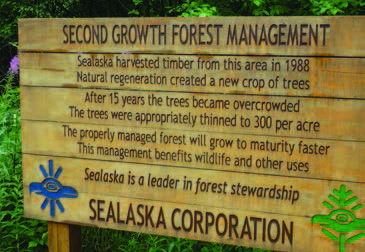Sealaska lands bill passes
Just before Christmas, Senator Lisa Murkowski secured final Senate passage of legislation supporting Southeast Alaska’s struggling timber industry and completing the federal land conveyance owed to Sealaska Corporation.
“It has taken seven years, but I’m proud to say that we finally completed the land conveyance for Southeast Alaska’s nearly 20,000 Native shareholders, and at the same time ensured that the region’s remaining timber mills have timber,” Murkowski said.
The measure provides Sealaska with 70,075 acres to finalize transfer of land owed to its Native shareholders under the 1971 Alaska Native Claims Settlement Act (ANCSA).
“Words cannot describe how pleased we are that this lands bill has passed through Congress,” said Sealaska President and CEO Anthony Mallott. “This is a monumental step to achieve our strategic plan of growth and profitability while maintaining important cultural priorities. I want to thank all the stakeholders who collaborated and partnered with Sealaska to make this happen.”
“Sealaska is responsible for providing meaningful economic and social benefits to shareholders,” said Rosita Worl, who chairs the Sealaska Lands Committee. “The board advocated for this legislation to support economic and cultural sustainability as well as economic diversity beyond timber development and this legislation will help us achieve these objectives.”
Sealaska will receive 68,400 acres for timber development, 1,099 acres for renewable energy resources and recreational tourism projects, and 490 acres of Native cemetery and historic sites.
Sealaska’s forested acreage is key to the survival of the local timber industry and the U.S. Forest Service’s efforts to successfully transition toward young-growth and away from old-growth logging in the Tongass. Sealaska currently produces about 40 percent of the Tongass’ timber and without the infrastructure the corporation funds, the rest of the industry might not be able to survive.
The measure also places 152,067 acres of old-growth timber in new conservation areas to protect salmon and wildlife habitat.
Sealaska’s current land base of 290,000 acres, together with the acreage in the new legislation, represents less than two percent of the Tongass National Forest or a fraction of the traditional homelands of Southeast Alaska Natives. Passage of the bill will also enable Sealaska to better contribute to the economy and help maintain a sustainable timber industry. Under ANCSA revenue sharing provisions, commonly known as 7(i), Sealaska will share its natural resource revenue with all Alaska Natives.
“Some 43 years after passage of ANCSA, the federal government will finally finish paying the debt we owe Natives for the settlement of their aboriginal land claims,” Murkowski said. She emphasized that passage of the bill was vital because an integrated timber industry is crucial for the economics of a timber industry, and for other industries that Southeast Alaska depends upon. “This bill also will allow Sealaska to transition from timber to promoting renewable energy development and tourism – all positives for the region,” Murkowski said.

Sealaska is a leader in forest stewardship.
Return to newsletter headlines